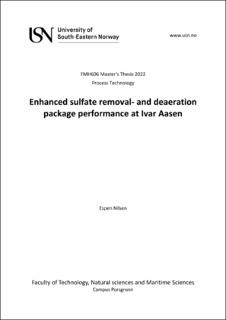| dc.description.abstract | Ivar Aasen is an oil and gas field situated in the northern part of the Norwegian continental shelf. A part of their operational strategy is to maintain reservoir pressure at a desirable level by injecting a combination of produced water and treated seawater into the reservoir. The seawater used for this purpose must be pretreated to remove both sulfate ions and dissolved oxygen to certain concentration levels. This is to prevent reservoir souring, scaling and corrosion damage in the topside process equipment and injection wells. At Ivar Aasen the sulfate and oxygen in the seawater to be injected are removed by nanofiltration and vacuum/chemical deaeration in two separate unit operations. The combination of the two is referred to as the Sulfate Removal Deaeration Package (SRDP).
The overall project objective was to evaluate and optimize the SRDP performance. The method to do so was to initially study the plant to set the frames for the subsequent literature review intended to theoretically evaluate unit performance and to understand the detailed mechanisms of the different unit operations. This was in turn utilized for the plant tests during the projects practical phase to assess the performance and optimization potentials.
The theoretical study made it clear that it was not possible to establish a theoretical performance model for the SRUs due to lack of publicly available information on the specific membranes in use. As a compromise a systematic overview of the expected SRU response upon parameter changes was established. During the plant specific SRDP study it was found that the SRUs are likely operated at too high total recovery relative to the manufacturer’s recommendations. In addition, assessment of historical data indicates that the deaerator vacuum ejector underperforms. This hypothesis that was strengthened during the practical phase of the project.
The practical phase of the project suffered from time constraints and process issues due to an unforeseen power loss at Ivar Aasen. This disabled the ability to elevate the seawater temperature to the SRDP for the remainder of the project period. In addition, Aker BP decided to start early on their planned maintenance shutdown while the plant was already without main power. This restricted the available resources for testing significantly during a large portion of the planned test period. The plant tests that were initiated (but not completed) involved increasing the seawater temperature, validation of a mathematical permeate flow model, and changes to stage recoveries by altering the permeate backpressure. The temperature test ended abruptly due to the mentioned power loss which made evaluating the test data difficult. Increasing the seawater temperature showed promising results regarding optimizing the sulfate removal system but could not conclude on how the rate of biofouling responds. The deaerator response was not significant, but the test yielded strong indications of underperformance. The data indicates the vacuum ejector as the reason for this underperformance. The theoretical performance model derived for the deaerator was not possible to validate with the little data available from this test. However, this derived model relative to the performance model made by the manufacturer, seems to predict the deaerator temperature response better. The next test involving validation of a permeate flow model was not completed but it proved that the model could be corrected to different levels of permeate production. The ability to deal with membrane fouling for this flow model was not tested, but the test data retrieved seems to indicate that it will fail to do so. The last test indicates that increasing the 1st stage recovery above a certain, unknown, level can increase the rate of membrane fouling. Thus, it is important with explicit control over the recoveries if these are to be altered to optimize the system. The temperature test and flow model validation should be resumed when possible. | |
